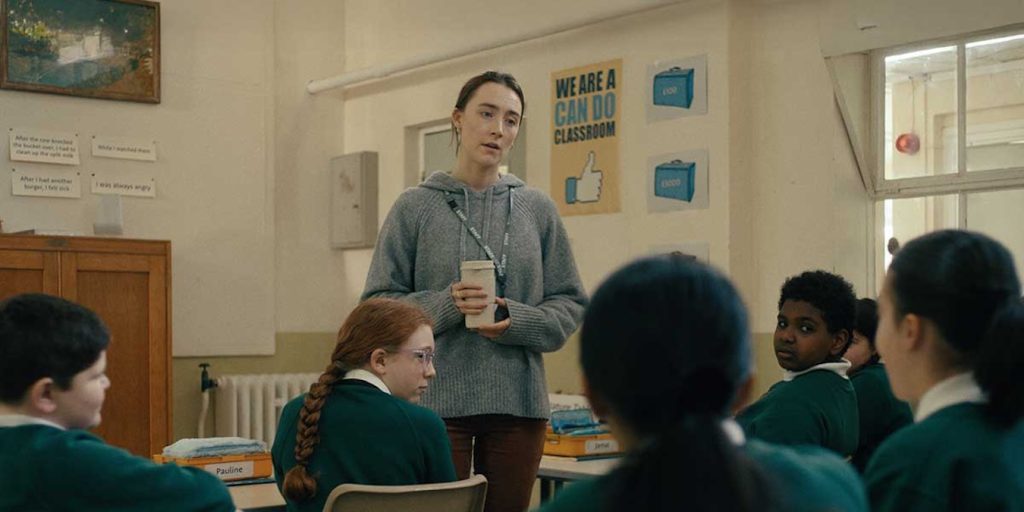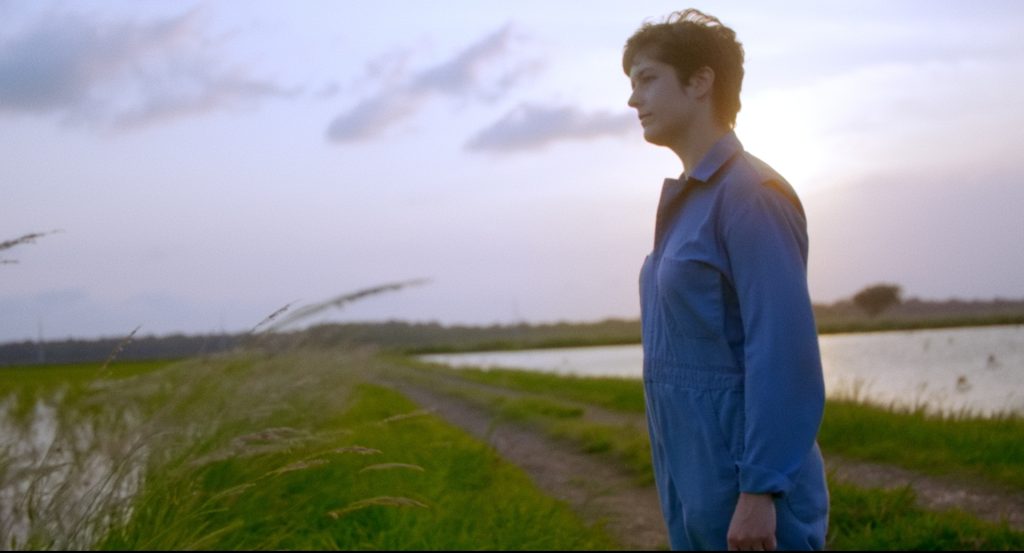After last year’s subdued edition, this year’s Sundance Film Festival — the 40th — feels a lot like a pre-pandemic Sundance. More journalists and industry people are in Park City; there are more parties, longer lines, a higher incidence of conversations that include the words “Don’t you know who I am?” Nature (or whatever this is) is healing.
The festival is so exciting, in fact, that we don’t have time for segues. Here are five assorted reviews.
In the aptly titled neo-noir Love Lies Bleeding (love, lies, and bleeding are indeed prominent themes), it is 1989 and a sad New Mexico lesbian named Lou (Kristen Stewart) is smitten with the new girl in town, Jackie (Katy O’Brian), a massive bodybuilder training for a competition in Las Vegas. Jackie takes a job at a gun range owned by Lou’s local crime-boss father (Ed Harris, bald with long gray hair) and lifts weights in the gym he owns. (Lou’s dad owns the local police, too, if you’re wondering.) Lou supplies Jackie with sex, a place to stay, and steroids.
The trouble arises not from the factors I just mentioned (well, the steroids, partly) but from Lou’s brother-in-law (Dave Franco), a loathsome creep who regularly beats up Lou’s sister (Jena Malone). Lou hates him, Jackie loves Lou, and Jackie has a tendency to hulk out, veins a-poppin’, when she gets angry. Is there room in this world for two bad girls in love and on the run, one desperately trying to quit smoking cigarettes and the other prone to violence?
The director, Rose Glass, is following up her acclaimed debut, Saint Maud, which was also about women on the edge of sanity. Co-writing with Weronika Tofilska, Glass really lets her freak flag fly in Love Lies Bleeding, mixing film noir tropes and brutal violence with fantasy and a bit of camp. I’ve seen movies where people ate bugs before, but I think this is the first time I’ve seen someone eat a bug in frustration. Is it an “authentic” character moment? No — it feels like Glass said (accurately), “It would be awesome if someone ate a bug.” There are several big choices like that here, just enough to remind you that you’re not watching something from the usual Hollywood factory. Grade: B
The latest meta-twist on the almost half-century-old slasher formula is In a Violent Nature, which is told mostly from the point of view not of the randy teens camping in the woods but of the masked, hulking boogeyman who stalks and eviscerates them. It’s Friday the 13th: Jason’s Version.
This isn’t the first post-Scream slasher movie to focus on the killer (see also Tucker and Dale vs. Evil and Behind the Mask: The Rise of Leslie Vernon), but it’s the first one I’ve seen that treats the idea seriously rather than tongue-in-cheek. First-time feature writer/director Chris Nash (who made the Z segment in ABCs of Death 2) uses a slow-burning, naturalistic approach, letting the camera tag along behind the silent maniac, Johnny, as he lumbers through the forest. The mood is serene and contemplative, like a Kelly Reichardt or Terrence Malick movie — except that occasionally there is a gnarly and disturbing murder that horror fans will want to tell their friends about. (Kudos also to the exceedingly gross sound design.)
Nash isn’t parodying slasher flicks here, though prior knowledge of slasher lore (the Friday the 13th series in particular) is necessary to fully appreciate the film’s details, including its occasional humorous moments. Nash follows the usual formula, simply moving the “main characters” to the periphery. We only hear as much of their rote conversations — the hot chicks they met at the gas station on the way out here, the legends about a killer who lives in these woods — as the killer overhears.
Following the monster instead of the victims necessarily reduces some of the suspense (his attacks are never a surprise to us), but the matter-of-factness — spending time with the monster absolutely does not make us like him — gives things a different kind of eeriness. That is, until the last act, when Nash shifts to a more traditional approach and the vibe changes. I’m a little stumped on whether the ending works. I really want to talk about those gnarly kills, though. Grade: B+

They’re asking critics not to spoil It’s What’s Inside, but what they consider a “spoiler” is what the dictionary would consider the “premise”: it’s what the movie is about. Did you feel like Jaws was spoiled for you when you heard it involved a shark? If not, you’ll probably be OK knowing ahead of time that It’s What’s Inside is a twisted comedy-thriller about body-swapping.
The setting is a reunion of college friends on the eve of a wedding. Cyrus (James Morosini) and Shelby (Brittany O’Grady), friends back then, are dating now, though not well. The groom-to-be, Reuben (Devon Terrell), hosting the party at his artist mother’s insane mansion, is having second thoughts (his fiancée wasn’t invited to this event, which seems like a red flag). The other friends are Instagram influencer Nikki (Alycia Debnam-Carey); hothead Dennis (Gavin Leatherwood); spacey Maya (Nina Bloomgarden); and we-needed-one-more Brooke (Reina Hardesty).
It’s an eighth friend, Forbes (David W. Thompson), whose arrival shakes things up. Forbes was a screw-up back in the day who had beef with everyone before being expelled from college. Now he’s an entrepreneur with a dopey, devilish grin and a suitcase containing an apparatus that allows everyone who plugs into it to temporarily swap consciousnesses.
This is a great concept with myriad possibilities, especially if (unlike most body-swap movies) you’re not going to be bound by decency or taste. Writer-director Greg Jardin goes all out in his feature debut, gleefully letting his characters do more or less what you’d expect hot dumb young people to do if they could possess one another’s bodies. How do you know who’s really in there? Maybe you’ve always been attracted to Dennis, for example, but hate the way he acts. Now’s your chance to hook up with Dennis’s body, inhabited by someone with a better personality.
The ensemble cast has a fine time impersonating one another, and their enthusiasm is infectious. It’s tricky, given that almost no one’s personality is well-defined before the swapping starts, but somehow everyone’s true character is revealed in all the hopping around. It’s a lot of fun, and Jardin does good work keeping us from getting too confused about who’s who.
My only real complaint might be a matter of personal taste: With all of the many possible directions this could have gone, I wish the film didn’t end up focusing so much on Cyrus and Shelby’s relationship. One imagines Jardin, delighted with himself (rightfully so) for the fantastic core concept he came up with, throwing everything he can think of at the screen, trying to cram it all into one movie. Not every angle of this eight-way web of intrigue is equally important or interesting, not when there are also matters of life and death involved. Grade: B

Four years after their Boys State documentary followed several teen male political nerds at a week-long government-themed summer program, directors Amanda McBaine and Jesse Moss have returned with Girls State, doing the same for the young ladies. It may seem like the usual sexism that the boys got their documentary before the girls did (and maybe it was), but it proves fortunate: Having already seen how the boys’ program works, we can compare the girls’ to it. And you’re never going to believe this, but it seems that Girls State isn’t nearly as well-funded or serious about politics as Boys State is.
This despite the female participants being every bit as passionate as their male counterparts. In fact, Girls State (the movie) is at its best when the girls are discovering the shaft they’re getting at Girls State (the program). When the boys elect their “governor,” the actual governor of their state comes to swear him in. The girls don’t get that. The girls also have a “Girls State” song they have to learn, complete with hand motions, and you know damn well the boys don’t have to do that. Do the girls have a stricter, more puritanical dress code than the boys? You bet!
It was filmed in Missouri in 2022, in the time after the Supreme Court’s reversal of Roe v. Wade had been leaked but before it was made official. Abortion becomes the central issue at this year’s Girls State, and some girls express disappointment that this and other real-world political issues aren’t being analyzed more fully. (“I’m a little sick of the fluff,” says one.)
One theme that emerges is the idea of finding a new path after Plan A doesn’t work out. Girls State holds elections for governor and attorney general, and appointments for the supreme court. What if getting a specific job was the whole reason you came to Girls State, and then you didn’t get it? What now? We see this play out a few times, where girls are forced to come up with a back-up plan. Inspiringly, they find fulfillment there, too, a testament to the power of a “nevertheless, she persisted” mentality. Grade: B-
The best joke in Sasquatch Sunset, which traces a year in the life of a family of Bigfoots, is in the casting. There are four Sasquatches, all played by actors completely covered in makeup and fur, speaking only in grunts, utterly unrecognizable — and yet two of them are played by name actors, Jesse Eisenberg and Riley Keough.
David and Nathan Zellner, the Austin-based brothers who made Kumiko, the Treasure Hunter and Damsel, are nothing if not committed to their oddball projects. This one is a decidedly unserious examination of Sasquatch life (and death), yet it has an undercurrent of relatable truth. Maybe not when one of the Bigfoots is trying to count higher than four, perhaps, or when they pretend to use a turtle as a phone (what?), but in other instances. Like how one of the male Bigfoots is always on the lookout for someplace new to insert his penis, or the way they all scream and throw their poop at things that upset them. This is recognizable behavior.
The Zellners get an impressive amount of mileage out of their sparse, almost plotless concept. (Nathan plays a third Sasquatch; the fourth is played by Christophe Zajac-Denek). Some viewers will find that it can’t sustain itself for 89 minutes, but I was amused and invested the whole time, caught up in the silly dramas and serious farces encountered by these ugly, coarse but lovable creatures. Grade: B-
All photos courtesy of the Sundance Institute.



